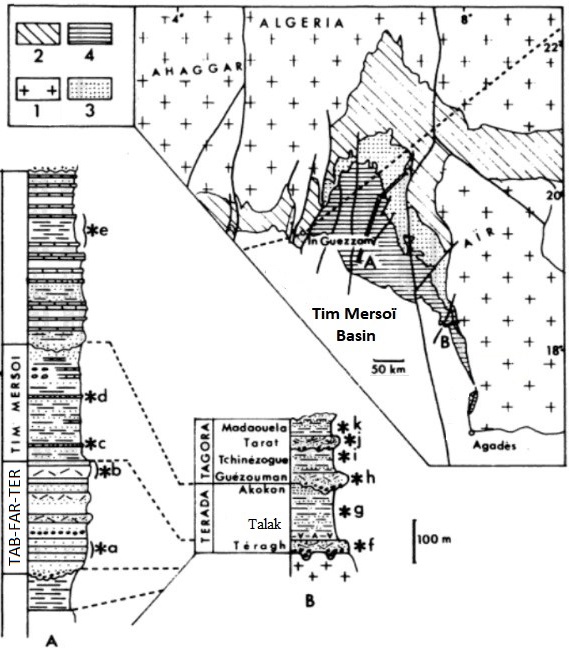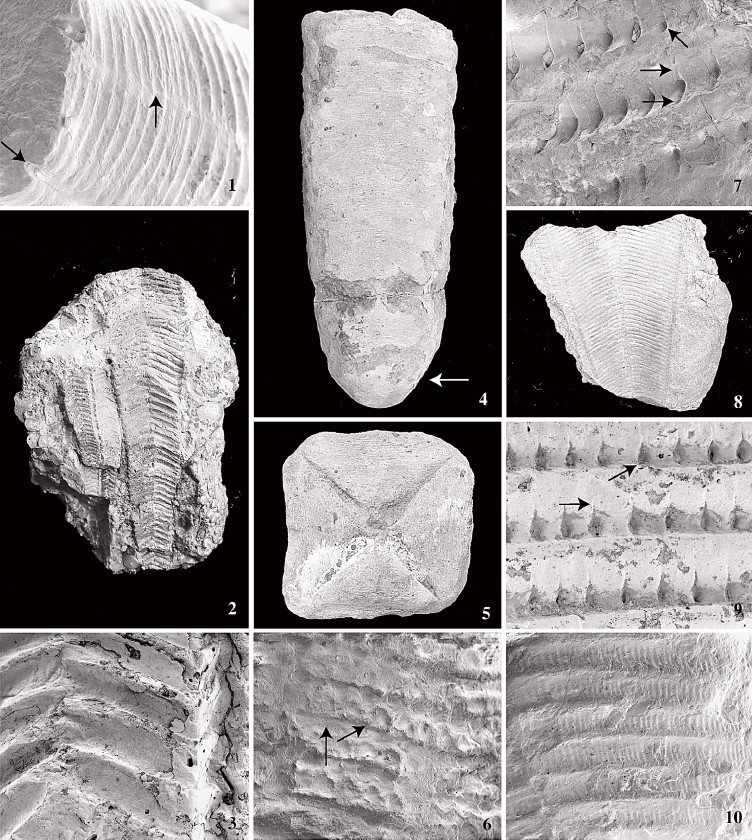Talak Fm
Type Locality and Naming
Joulia (1959). emend. Claret & Tempère (1968). Terada Gr.
References: Joulia, 1959; Claret & Tempère, 1968; Valsardieu, 1971; Legrand-Blain, 1974, 1985; Sempéré, 1981; Fabre et al., 1983; Legrand-Blain, 1985; Conrad et al., 1986; Crasquin-Soleau et al., 1987; Yahaya, 1992; Coquel et al., 1995; Babcock et al., 1995; Van Iten et al., 2008.
Synonym: "Série de Talach"; Talach argillites; Talak argillites; Equivalent(s): Tim Mersoï Fm (south of In Azaoua); Aoulingen Fm. Synonym for Akakan Mbr = Unité d’Akokan
[Figure 1: Tim Mersoï Basin Equivalents]
Lithology and Thickness
Joulia (1959) describes the formation as siltstone with plants, gypsiferous purple clays, levels of micro-conglomerates, sandstone beds and phosphate nodules. An angular unconformity surface truncates the top of the formation with erosion up to 50 m deep. For Valsardieu (1971), it represents the median unit of the Terada Gr. Thick and marine in the north (gypsum and Productidae clays), they pass in the south to lacustrine clays and siltstones with plants (Rhacopteris) and layers of coal (Aoulingen region, also commonly called the “Agadez Coal Basin” near Arlit) and end in a bevel between the top of the “Grès de Teragh” [Teragh Fm] and the base of the “Grès de Guezouman” [Guezouman Fm]. Van Iten et al. (2008) describe the formation as consisting predominantly of dark shales with rare quartz siltstone beds (lower part) and discontinuous beds of quartz sandstone and pebbly quartz sandstone (upper part). Its thickness is 50 to 110 m. Upper unit is the Akokan Mbr = 40 m of Clay-siltstone, fine sandstone facies typical of tidal environments
Relationships and Distribution
Lower contact
Transgressive on the Teragh Fm and/or the basement.
Upper contact
Overlying unit is the Téléflak Mbr of the Guezouman Fm (Tagora Group) (when present); otherwise, the Guezouman Fm. Erosional disconformity/Angular unconformity
Regional extent
GeoJSON
Fossils
Lamellibranchs, brachiopods (like those in the Tim Mersoï Fm.) and crinoids. A fossil level at the base yielded Productus antiquatus, P. scabriculus, P. vaughani, P. semireticulatus, Syringothyris cuspidata. Plants (Rhacopteris) and coal. The shales and coarser interbeds contain marine invertebrates (including productids, spiriferids, Lingula, and ectoprocts), often preserved in phosphatic nodules, and gypsum crystals are present in some parts of the shales. Van Iten et al. (2008) believe that the uppermost part of the Talak Formation of northern Niger contains at least two and possibly four species of Paraconularia, a single species of Conularia Miller in Sowerby, 1821, and, perhaps, two species of Climacoconus Sinclair, 1942.
[Figure 2: Conulariids (an extinct group of marine cnidarians) from the Talak Formation (Source: Van Iten et al., 2008)]
Age
Depositional setting
The Talak Formation was probably deposited in a shallow, variably restricted epicontinental sea close to an estuarine or deltaic environment. The sandstone beds containing conulariids (Fig. 2) were deposited from bottom currents on progradational slope bars. Thus, as Babcock et al. (1995) suggested, the conulariids probably underwent transport or reworking prior to final burial. The facies of the upper unit, the Akokan Mbr, is typical of tidal environment.
Additional Information

